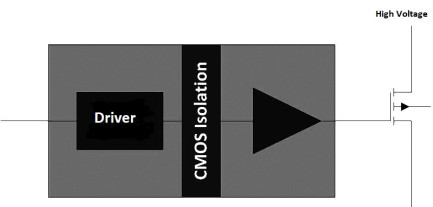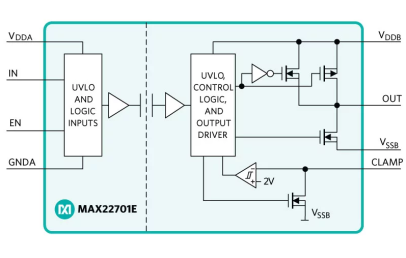Using silicon carbide gate drivers can reduce energy loss by 30 percent while maximizing system uptime.
Maxim Integrated has introduced a silicon carbide (SiC) isolated gate driver for use in high-efficiency power supplies for the industrial market. The company claims the new device has 30 percent lower power loss and a 30 percent lower carbon footprint compared to competing solutions.
System manufacturers are increasingly interested in increasing the power efficiency of their designs; the combination of energy efficiency and reduced costs is becoming critical market leadership. Considerable progress has been made in this area from a semiconductor materials perspective, and there are now products that can switch at high speeds, providing improved system-level efficiency while reducing size.
As devices become smaller, power supplies need to keep up with the pace. Therefore, today’s designers have a priority objective: maximize power per volume (W/mm3). One way to achieve this is to use high-performance power switches. The path of the new power electronics is already being paved with GaN (gallium nitride) and SiC, even if further R&D programs is still needed to improve performance and safety, and even though designing with these wide bandgap (WBG) materials require extra work during the design phase.
Properties such as bandgap (eV), breakdown field, thermal conductivity, electron mobility, and electron drift velocity are the main benefits engineers that can gain from the use of WBG semiconductors such as GaN and SiC. The advantages of WBG semiconductor power switch modules include high current density, faster switching, and lower drain-source resistance (RDS (on)).
SiC will set the rate of power in several industrial applications. It has a bandgap of 3.2 electron volts (eV) and the energy required to move the electrons in the conduction band provides higher voltage performance than silicon of the same packaging scale. Higher temperature working range and thermal conductivity support efficient thermal management.
Many switching power applications are adopting SiC solutions to improve energy efficiency and system reliability.
The high switching frequency in the power supplies causes operational difficulties for noise-creating transients, making the overall system inefficient. The chemical structure of the new technologies, compared to that of silicon, makes the new devices low-charge with the opportunity to switch quickly.

Isolated gate drivers are widely used to drive MOSFETs and IGBTs and provide galvanic isolation. Switching frequencies above 10 kHz are common in MOSFETs and IGBTs. However, SiC- and GaN-based systems can operate at even higher switching frequencies without significant power losses during the transition. Significant advantages are size reduction and less distortion (figure 1).
Fast switching produces noise transients that could cause loss of modulation or even permanent damage to the system due to the latch-up phenomenon. To solve this problem, it is necessary to improve the noise immunity of the components used to drive the system. Power dissipation during switching, or conduction losses, produce heat that must be dissipated through the heat sinks. The size of the heat sinks increases the solution sizes.
The intensity of these transients may result from the driving circuit of the spurious pulse gate resulting in a short circuit condition. The drive circuits controlling the power converters must be designed to withstand these noise sources and, thus, possible secondary short circuits. The ability of driver circuits to withstand these common-mode noise transients is defined by a common mode transient immunity (CMTI) which is expressed in kV/µs, and it is a key parameter for all gate drivers that handle differential voltage between two separate ground references (isolated gate drivers). Understanding and measuring sensitivity to these transients is an important step in the design of new power supplies. The capacitance across the barrier provides the path for these fast transients to cross the isolation barrier and corrupt the output waveform.
The new MAX22701E driver has a high CMTI immunity of 300 kV/µs, which results in longer system uptime. The driver is designed for switching power supplies in high power industrial systems such as solar inverters, motor drives, and energy storage systems. MAX22701E is compatible to drive SiC or GaN FETs. Technical specifications significantly reduce downtime and energy losses. The MAX22701E is available in an 8-pin (3.90mm x 4.90mm) narrow-body SOIC package with an extended temperature range from -40 to +125 degrees Celsius (figure 2).

Figure 2: block diagram of MAX22701E
High CMTI determines the correct operation of the two sides of the driver minimizing errors, and therefore the robustness of the gate driver used. CMTI is one of the three key features associated with isolators. Other key features are propagation delay matching and the working voltage. MAX22701E offers industry’s lowest part-to-part propagation delay matching of 5ns (maximum) between the high-side and low-side gate drivers. This helps to minimize the transistors dead time and maximize power efficiency. The part offers robust galvanic isolation of 3kVRMS for 60s.
“With the increasing progress and adoption of power semiconductor devices such as SiC and GaN, the industry is moving towards more energy efficient and reliable solutions. The equipment requires increasingly high-performance switching frequencies, with high dv/dt characteristics when switching transients on/off compared to conventional MOSFET and IGBT solutions. Our Isolated SiC Gate driver provides a solution to maximize the system power efficiency and increase uptime in noisy environments; “ said Suravi Karmacharya, senior business manager, Industrial and Healthcare Business Unit at Maxim Integrated.